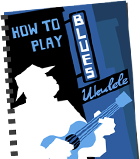Mumford and Sons – Little Lion Man (Chords)
There’s been a fair bit of Grammy-bashing around here but this set of performances from Mumford & Sons, The Avett Brothers and a Bob Dylan impersonator was incredible.
Since the last time I did some Mumfords, Marcus has picked up the ukulele. Until some uke action crops up on record, here’s a uke version of Little Lion Man.
Suggested Strumming
This strum will see you through the intro, the verses and the loud choruses:
A lot of the time – particularly the verses – he’s playing this with palm muting on the down strums. That means you rest the bottom edge of your palm on the string just in front of the bridge as you strum. It’s a bit like a chnk but you keep your hand on the string as much as possible.
Here’s a video (playing it slow then up to speed) which may or may not make things clearer.
For the middle section, do all down strums. Four times for C and F and eight times for Bb. You can fancy it up a little – like he does – by doing a quick up-strum before each chord change. As it gets louder he goes back to the main strumming pattern.
Twiddly Bits
In the intro (picked up again later in the song) there’s a switch between F6 – F – Fadd9 – F during the first bar of the F chord:
In the intro (and verse 2) the banjo adds a couple of B flats to the chords like this:
The little banjo solo after the first chorus is tricky to transfer to uke. I’ve included a version of it in the chord sheet (make sure you fret the C-string with your ring finger if you’re attempting it). It sounds like this:
But you can make it much easier to play without losing much by leaving out the hammer-ons and playing it like this:
UPDATE: If the video is blocked where you are, check the comments for some alternatives.
Requested by pretendings and Anika.








For musical theory n00bs like yours truly, do I need to tune it down a step? It sounds alright as it is to me now, but my ears are as trained as 1783.
(the locomotive engine was invented in 1784, horrible pun but I love bad jokes too much to leave it out).